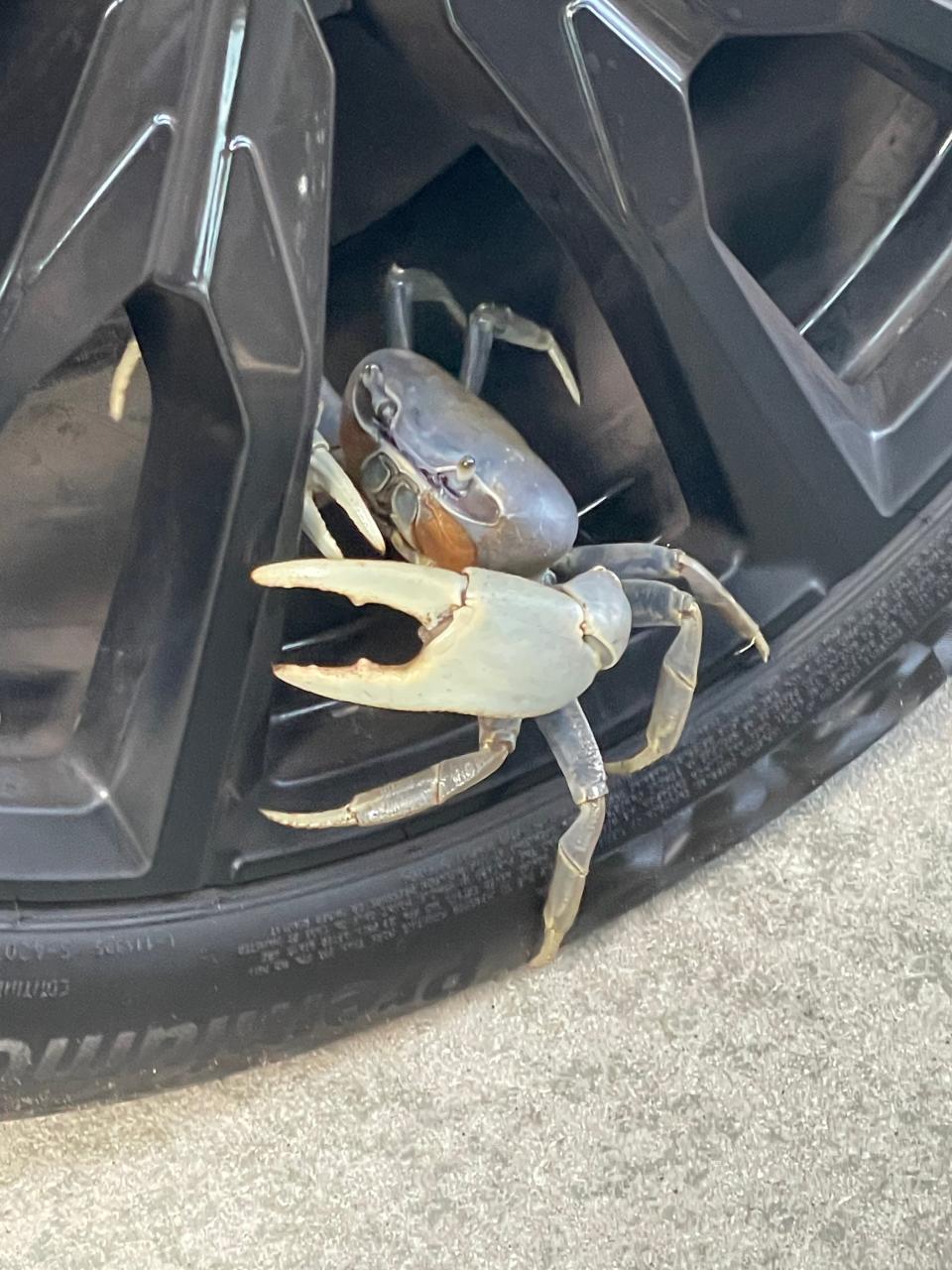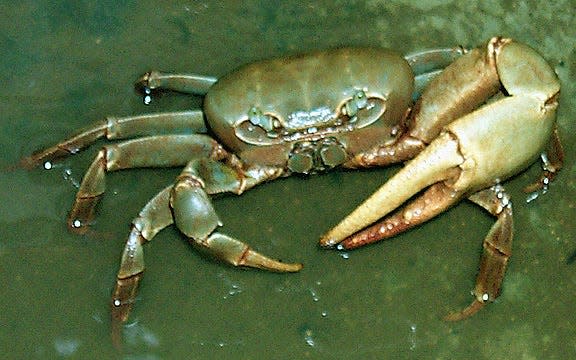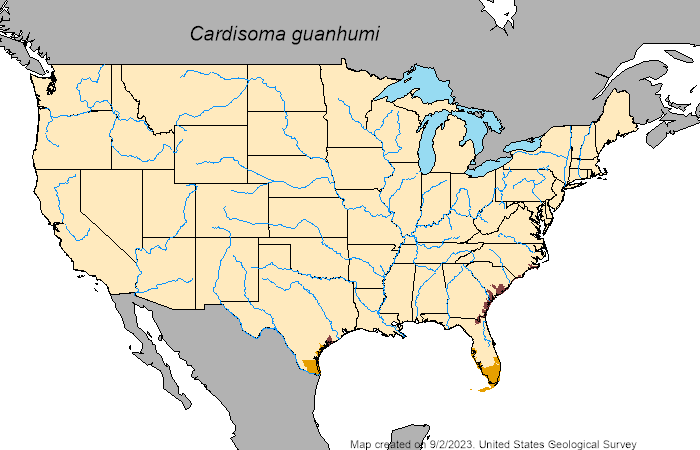What the crab is that? Researchers ask public for help in tracking new arrival to NC coast
Imagine a ghost crab combined with a fiddler crab. Now imagine that hybrid on steroids, like the performance-enhancing drugs used by professional baseball players in the 1990s.
That image effectively describes one of the newest non-native species to make North Carolina home, at least for a visit.
Now researchers, teaming up with fellow scientists in South Carolina, want the public's help to find out if a crab native to warmer climates thousands of miles south of North Carolina will become a permanent member of the Tar Heel State's environment.
"If you see one, you know it's something different," said Dr. Bronwyn Williams, research curator with the N.C. Museum of Natural Sciences, about the blue land crab.
As big as a good-sized coconut or cantaloupe when counting the breadth of its legs and claws, cardisoma guanhumi is hard to miss as it scuttles along coastal areas.
How long it's been exploring North Carolina's coastal areas isn't known, although it was first spotted this summer. Williams said it also isn't know if the large crab, while not native, will cause any long-term ecological damage to the coast's fragile marine environment.
“We definitely don’t have information to state that," she said. "We know it's here, but at this stage we don’t know what its impacts are."

What is a blue land crab?
Despite the similarity in name to one of North Carolina's favorite seafoods, the blue land crab shares little in common with the state's traditional blue crabs.
First and foremost, the crab dwarfs its smaller cousin. The blue land crab's main shell can be up to 6 inches in diameter, with the animal's walking legs and claws easily doubling the crab's size beyond its softball-sized carapace.
Then there's that main claw.
"That claw is very impressive," Williams said, "and they will defend themselves with it, so this crab is certainly something you want to approach with a degree of caution."
The big crab also is a landlubber. While it can swim and tolerates brackish waters, the land crab feels much more comfortable on, well, terra firma, according to the U.S. Geological Survey. It is rarely found more than 5 miles from the coast, and lives in burrows that can be quite extensive. According to the University of Florida, the crab's burrows can reach up to 5-feet deep, damaging gardens and lawns and posing a hazard to humans and livestock.

Unlike its smaller cousin, the land crab also is a vegetarian, grabbing fresh plant shoots, fruits and crops that are found near coastal waters before retreating to its burrow. Although there have been reports of the crabs feeding on animal carcasses and practicing cannibalism, these actions are thought to be rare.
Adult animals are often blue, while young animals can be variable in color from blue-blue-grey to tan and white, while females can change colors from blue to purple or violet during mating periods or when young.
Like other crab species, blue land crabs are known to live in colonies in their native range. They also are prolific breeders, with females able to produced hundreds of thousands of eggs several times a season.
Hitching a ride to the mainland
So how did this crab-on-steroids potentially make it to the U.S. mainland and then North Carolina?
Williams said the land crab is believed to be native to South and Central America and the Caribbean. It was first discovered outside its historical range in the U.S. Gulf Coast and Florida, as far north as Vero Beach, in the 1960s. Then its progression stopped, until an individual was found near Charleston, S.C., in the late 1970s.
Sightings then went dormant again until the 1990s, when more crabs were spotted around Charleston.
Williams said things went generally quiet again until a couple years ago when sightings started coming in from areas north of the Holy City up into the Grand Strand.
DWINDLING STOCK NC's blue crab numbers have been dropping for years, and the possible reasons why are many

Then in July a blue land crab was confirmed in Bogue Sound near Emerald Isle, roughly 100 miles north of Wilmington. Since then nearly 10 sightings have come in from nearby Morehead City and other areas in Carteret County.
Williams said it isn't known how the crab reached the U.S. mainland and is moving up the coast. But that both Charleston and Morehead City have international ports could hold a clue. The idea of the crab catching a ride on a ship as a means of moving around has gained momentum after recent unconfirmed reports of blue land crab sightings in Norfolk, Va., she added.
"But it also could be larvae just floating up the Gulf Stream or crabs hitching a ride on a boat trailer or luggage, too. An escaped pet is also a possibility," Williams said. "But at this point, we just don't know."
What's next?
Recent heavy rains tied to Tropical Storms Idalia and Ophelia likely have forced any blue land crabs along the N.C. coast to exit their deep burrows and either wait until they dry out or start excavating new ones.
Since the crabs are most active during the day, researchers are hoping this will make them more visible and are asking the public to report any sightings − preferably with visual evidence.
“We're really interested in having public collaboration with this and not just with sightings, but help in understanding what these crabs are doing while they're here," Williams said.
That work could include setting up camera traps near crab burrows to document their behavior and what they're eating. Capturing any specimens also could help biologists determine where these Tar Heel interlopers came from and if anything else, say a bug, parasite or other organism that might be detrimental to the environment, came along for the ride, too.
Climate change also could be playing a key role in helping the heat-loving blue land crabs expand their range since forecasters expect North Carolina's climate to warm considerably in coming decades.
ON THE MARCH A warming ocean is helping a flesh-eating bacteria creep north. What it means for the NC coast.
Already critters from flesh-eating marine bacterium to fire ants to armadillos are moving up the Eastern Seaboard into North Carolina as the climate grows hotter and more humid and rainfall becomes less predictable.
"We are basically creating great environments for these warm-loving creatures," Williams said of the results of humans for decades pumping massive amounts of heat-trapping greenhouse gases into the atmosphere.
She added that the recent arrival of the blue land crabs in North Carolina offers a chance for researchers and citizen-scientists to track their impacts on the environment and how they're interacting with the state's native flora and fauna from an early stage.
"This sort of opportunity doesn't come along very often," Williams said. "But the critical first step is documentation, because we just don't know a lot about what's going on with these guys right now."
Seen a big, strange-looking crab on the beach? To report blue land crab sightings, click here. For more information, contact Bronwyn Williams (bronwyn.williams@naturalsciences.org) with the N.C. Museum of Natural Sciences or Robert Corbett (Robert.corbett@deq.nc.gov) with the NC Division of Marine Fisheries.
Reporter Gareth McGrath can be reached at GMcGrath@Gannett.com or @GarethMcGrathSN on Twitter. This story was produced with financial support from 1Earth Fund and the Prentice Foundation. The USA TODAY Network maintains full editorial control of the work.
This article originally appeared on Wilmington StarNews: Blue land crabs spotted in NC as researchers scramble to gauge impacts

